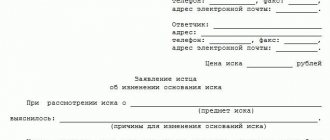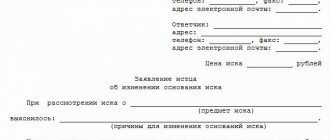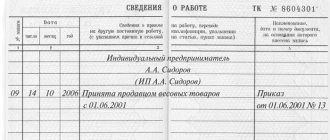Most people have faced the need to go to court at least once in their lives. Indeed, disputes and conflicts often turn into litigation. And the first thing you need to do when going to court is to draw up a statement of claim. It represents the procedural form of your claim. The claim states what the plaintiff wants to get and why the court should satisfy his demands.
It is often difficult for a person not versed in legal subtleties to correctly substantiate and state his claims, because the law imposes a fairly significant number of requirements on a claim. If they are not followed, the claim may be rejected or left without consideration. In this article we will talk about the main issues and nuances associated with drawing up and filing a claim.
We are trying to resolve the conflict without trial
Before filing a claim, it is often necessary to send a claim to the potential defendant, which also needs to indicate a deadline for a response. By default, the usual response time is one month from the date of receipt of the complaint.
If during this time your requirements set out in the claim are not satisfied, you do not resolve the issue amicably, or the claim remains completely unanswered, then you can safely go to court. A mandatory claim procedure is provided for a significant part of claims; in addition, by filing a claim it is often possible to resolve the issue without bringing the matter to court. Whether you need to submit a claim before filing a claim, you can consult a lawyer or try to figure it out on your own:
https://www.consultant.ru/document/cons_doc_LAW_188617/
Important!
If the claim has one subject and basis, and the claim has another, the court will return the claim or leave it without consideration. For example, in a claim you demand to change the terms of the contract, and in a lawsuit you demand to terminate it. In such a situation, the court will not consider your claims.
We formulate the subject and basis of the claim
Every claim must have these two elements. The subject matter is what the plaintiff demands. The basis is the circumstances to which he refers to substantiate his claims. Let us take, for example, a statement of claim for the recovery of an item from someone else’s illegal possession (vindication claim).
In order for the court to satisfy the requirements, you need to provide a reason. In the case of a vindication claim, the basis will be the following legal facts: the circumstances under which the thing left the possession of the plaintiff, the conditions of its receipt by the defendant (the one against whom the claim will be filed), the presence of this thing in his possession and the absence of obligations regarding it ( for example, the absence of a situation where the plaintiff transferred it under an agreement for storage to the defendant).
In what cases is it served?
An explanation is one of the types of clarifications of the initially submitted application. In the event that the court does not have enough information about the case that was provided in the initial application. The court may demand an explanation due to the fact that the claim contains insufficient circumstances, grounds, or a list of documentation, etc. needs to be supplemented.
As part of arbitration processes, an explanation may be required to clarify the circumstances, and are most often used when considering claims for recovery by way of recourse, when in the original document the applicant did not indicate the basis for the emergence of such a right. An explanation is also sent by the plaintiff in cases where the calculation of the application is not provided as part of the initial appeal for the recovery of funds, etc.
Info
The document in question can be sent not only by the plaintiff based on a previously submitted application, but also by the defendant, and even third parties. This is done in order to convey to the court the position of the participant in the proceedings. The consequence of such an addition may be a summons to court to testify.
Let's start with the “cap of the claim”
The first thing to do is to indicate to which court the application is being filed, who the defendant is, third parties and information about the plaintiff.
1. In the information about the plaintiff, you will need to indicate the full name or name of the organization, place of residence or location, if a representative is filing - also his data.
2. About the defendant you will need to indicate his full name or name and location or residence. Until January 1, 2021, the new edition of clause 3 of Art. 131 of the Code of Civil Procedure of the Russian Federation, which requires indicating the place where he was born and where he works, as well as one of the identifiers (inn, series and number of a passport or driver’s license, personal identification number, PTS) will do, if this information is known.
3. It is also advisable to indicate the price of the claim in the header - this is the cost of the claims, if they are subject to assessment. For example, if you are collecting a debt of 300 thousand rubles, then this amount will be the cost of the claim.
Instructions for writing an explanatory note
An explanatory note from the point of view of the norms and rules of office work has a completely standard structure and should not cause much difficulty when writing
In the “header” of the document in the upper right corner you must enter information about the addressee .
- First, the position of the employee in whose name it is drawn up is indicated (director, general director, head of department, group leader, etc.).
- Then write the full name of the organization, indicating its organizational and legal status (IP, LLC, ZOA, OJSC), as well as the surname, name, patronymic of the addressee.
- After this, information about the employee is recorded in exactly the same way (position, company name, last name, first name, patronymic).
- Next, indicate the locality where the enterprise is registered, as well as the date the application was written.
Then in the center of the line you need to write the name of the document with a short description of its essence (in this case, “about being late for work”).
The second part is the main one. Here you must provide only the facts and reasons for the offense , and you should try to give a correct explanation with clear wording and arguments. If there is written evidence of the employee's innocence, this should also be noted. There is no need to write a lot and in great detail - no one will read several pages of text, moreover, such an explanation may cause a negative reaction from the employer.
The application must be signed with a mandatory decryption of the signature and handed over either to the secretary or personally to the immediate supervisor.
We declare our position
After the factual circumstances are described, you can move on to your opinion as to why the court should satisfy the requirements. In the case of the same lease agreement, you can indicate that the tenant did not pay rent more than two times in a row, indicating that this is the basis (clause 3 of Article 619 of the Civil Code of the Russian Federation) for terminating the contract.
Important! Due to the direct requirement of the law, when collecting funds, the claim must necessarily include a calculation. For example, you are collecting a penalty under a contract. In the claim, you will need to refer to the relevant clause of the contract and calculate the penalty using a formula or using a table that will need to be inserted into the claim.
Explanations on the arbitration case
With this material we present for review written explanations of the case developed for one of the arbitration construction disputes. The judge suggested making a document of this nature after her decision (in our favor) was overturned by the cassation court. In our explanations to the court, we analyze in detail the construction of evidence in a construction case with references to the rules of law. The procedural document below demonstrates the level of formation of such evidence with which the judge will be comfortable working.
To the Moscow Arbitration Court
115191, Moscow, st. Bolshaya Tulskaya, 17
Plaintiff: Limited Liability Company "Teplovent" (LLC "Teplovent")
129366, Moscow, Yaroslavskaya street, building 10, building 5, floor 3 room i room 5A
Defendant: Limited Liability Company "AGDA" (LLC "AGDA")
302027, Oryol region, Orel city, Oktyabrskaya street, building 211, letter A, room 114
Case No. A40-122082/19-96-1080
Written explanations
according to the arguments specified in the Resolution of the Arbitration Court of the Moscow District dated March 4, 2020.
On 09/04/2019, the Arbitration Court of the city of Moscow in case No. A40-122082/19-96-1080 made a decision (hereinafter referred to as the decision dated 09/04/2019), according to which AGDA LLC (defendant, executor) in favor of LLC Teplovent (plaintiff, customer) was charged the amount of unjust enrichment in the amount of 500,000 rubles, a penalty in the amount of 102,935.50 rubles, the cost of paying state duty in the amount of 15,059 rubles, the counterclaim was rejected in full.
By the resolution of the Ninth Arbitration Court of Appeal dated November 27, 2019 (hereinafter referred to as the resolution dated November 27, 2019), the decision dated September 4, 2019 was left unchanged.
By the resolution of the Moscow District Arbitration Court dated 03/04/2020 (hereinafter referred to as the resolution dated 03/04/2020), the decision dated 09/04/2019 and the resolution dated 11/27/2019 were cancelled, and the case was sent for a new trial.
In its ruling dated March 4, 2020, the cassation court indicated a number of arguments that must be taken into account when re-examining the case.
Regarding the arguments set out in the resolution dated March 4, 2020, Teplovent LLC provides written explanations No. 2 in accordance with Art. 81 of the Arbitration Procedural Code of the Russian Federation (hereinafter referred to as the Arbitration Procedure Code of the Russian Federation).
There may be several written explanations, in which case they need to be numbered
1. The evidence of work performed by the defendant does not meet the criteria of relevance and admissibility (Articles 67, 68 of the Arbitration Procedure Code of the Russian Federation).
The cassation court, in its ruling dated March 4, 2020, pointed to a number of documents that were subject to verification and evaluation as evidence of the defendant’s performance of work.
The documents specified in the resolution dated 03/04/2020 do not confirm the performance of work by the defendant.
Between Teplovent LLC (customer) and AGDA LLC (contractor) an Agreement dated November 9, 2018 No. 909-11/18-1 was concluded for the performance of work (hereinafter referred to as the agreement).
The subject of the contract was the execution by the contractor of a set of works to develop a dispatch of limited functionality.
Statements of quantities of work performed (T2 ld 22-24) relate to the installation of an automation system for general ventilation, in which the contractor is Teplovent LLC.
Acts of acceptance for operation of the automation (T2 ld 25-65), acts of transfer of supplied equipment of the automation (T2 ld 37-38, 54-55, 64-65) relate to the automation of general ventilation, but not to dispatching, Teplovent LLC is also indicated as the contractor.
On the diagrams of dispatch systems, plans for laying cable lines and equipment location (T1 ld 124-128), there are no signatures in the stamp, and there are no signatures of the customer.
Reports on setting up equipment, photo reports of equipment testing (T1 ld 108-163) cannot confirm the execution of work by the contractor, since there is no commissioning program signed by the customer, as provided for by the standards of SP 48.13330.2011. Set of rules. Organization of construction. Updated version of SNiP 12-01-2004 (approved by Order of the Ministry of Regional Development of the Russian Federation dated December 27, 2010 N 781), it is not possible to correlate these documents with the subject of the contract.
Meanwhile, the contract does not provide for such type of work as installation of an automation system for general ventilation, as well as commissioning of these systems. The agreement provides for the development of a dispatch system of limited functionality and carrying out commissioning work on general ventilation systems, and not on their automation systems.
From the acts of transfer of supplied equipment, certificates of installation of the general ventilation automation system, and acceptance certificates for the commissioning of the general ventilation automation system submitted to the case materials, it follows that the concept of “general ventilation automation system” refers specifically to control panels and their components, and failure to install dispatch systems (laying the appropriate cable system).
Additionally, it should be noted that the defendant is not indicated anywhere in the listed documents.
Neither the law nor the terms of the contract provide for the possibility of confirming the completion of work by publications in the media (T2 ld 205-206). Publications in the media cannot confirm either the performance of the work by the contractor, or the circumstances of the delivery of the facility and its commissioning.
Thus, the evidence mentioned above does not meet the criteria of relevance, admissibility and reliability of evidence, since it does not indicate the completion of the work provided for in the contract.
2. The refusal of Teplovent LLC from the contract is due to the failure of AGDA LLC to fulfill its obligations under the contract - failure to complete the work.
Due to the contractor’s violation of the deadlines for completing the work established by the contract, the customer refused to fulfill the contract and demanded the return of the transferred advance payment in the amount of 500,000 rubles. (claim dated March 19, 2019)
In its ruling dated March 4, 2020, the cassation court indicated the need to take into account the motive and grounds for termination of the contract.
The claim dated March 19, 2019 from Teplovent LLC to AGDA LLC states that AGDA LLC did not fulfill its obligations under the contract and did not complete the work. Considering that the refusal of the contract was motivated by the failure of AGDA LLC to perform the work provided for in the contract, then clause 2 of Art. 715 of the Civil Code of the Russian Federation (hereinafter referred to as the Civil Code of the Russian Federation).
Guided by Art. 168 of the Arbitration Procedure Code of the Russian Federation, the court of first instance came to similar conclusions in its decision dated September 4, 2019.
From the case materials it follows that the refusal of Teplovent LLC from the contract is due to the failure of AGDA LLC to fulfill its obligations under the contract.
In addition, regardless of the grounds for termination of the contract (clause 2 of Article 715 of the Civil Code of the Russian Federation / clause 2 of Article 717 of the Civil Code of the Russian Federation), only completed work is subject to payment. Meanwhile, in the case materials there is no evidence of the work performed by the contractor.
The norm of paragraph 4 of Art. 753 of the Civil Code of the Russian Federation, clauses 4.1., 4.4. The contract stipulates that the execution and delivery of work is formalized and confirmed by certificates of completed work.
The unilaterally signed certificates of completed work were sent to the plaintiff on 04/02/2019 - after the plaintiff refused the contract.
If the work is delivered by the contractor after termination of the contract, then unjust enrichment arises on the contractor’s side in the amount of the unpaid advance; the unpaid advance must be returned to the customer.
Written explanations significantly help the judge motivate the court decision
3. There is no evidence of sending certificates of work performed before notification of termination of the contract.
In the ruling dated 03/04/2020, the cassation court indicated that there was evidence that the act was sent to the plaintiff on 04/02/2019 by mail - before receiving notice of termination of the contract.
This conclusion of the cassation court is refuted by the case materials.
The claim (notice of refusal to fulfill the contract) dated 03/19/2019 was sent to AGDA LLC by Russian Post on 03/25/2019 (RPO 12703032060961).
As follows from the information posted in the “Tracking of Postal Items” section of the Russian Post website, the specified claim/notification dated March 19, 2019 arrived at the place of delivery on March 28, 2019, and was received by AGDA LLC on April 12, 2019.
The claim/notification dated March 19, 2019 was in the delivery post office for more than two weeks before AGDA LLC received this postal item.
Avoiding receiving the claim/notification dated March 19, 2019 from Teplovent LLC, AGDA LLC sent a counterclaim on April 2, 2019.
Thus, the notice of Teplovent LLC about the refusal of the contract was sent to AGDA LLC on March 25, 2019, arrived at the place of delivery and was available for receipt from March 28, 2019 - until AGDA LLC sent a counterclaim and certificates of work performed to Teplovent LLC.
In its ruling dated March 4, 2020, the cassation court indicated that the documents were transferred secretly to D.A. as a representative of the customer.
However, evidence of the transfer is hidden by D.A. or his signing of acts of work performed, as well as evidence of notification of this to Teplovent LLC, are absent in the case materials.
As evidence of the transfer of documents, the defendant refers to an email dated December 24, 2018.
In paragraph 65 of the Resolution of the Plenum of the Supreme Court of the Russian Federation dated June 23, 2015 N 25 “On the application by courts of certain provisions of Section I of Part One of the Civil Code of the Russian Federation” is explained, unless otherwise established by law or agreement and does not follow from custom or practice established in relationships parties, a legally significant message may be sent, including by e-mail, fax and other communications, carried out in another form corresponding to the nature of the message and relationships, information about which is contained in such a message, when it is possible to reliably establish from whom the message came and to whom is it addressed?
The agreement concluded between the parties does not provide that legally significant notifications can be sent by email; the agreement does not indicate the email addresses to which the parties receive messages.
The recipients of the email dated December 24, 2018 “hidden”, “hidden” are in no way correlated or identified with Teplovent LLC, and therefore it is impossible to reliably establish to whom the letter was addressed and by whom it was received.
The other electronic correspondence presented by the defendant is not informative, since it is also impossible to reliably determine the addressees from it and its relevance to the subject of the contract.
Clause 4.2. The contract stipulates that acceptance is carried out by an authorized representative of the customer.
Dyudin D.A. did not have the authority to sign documents on behalf of the customer; there is no relevant evidence in the case materials.
Thus, the defendant did not provide evidence of the completion of the work, delivery by the contractor and acceptance of the work by the customer: certificates of completion signed by the parties or sent to the plaintiff. The evidence presented by the defendant does not meet the criteria of relevance and admissibility, since it is not related to the subject of the contract.
Based on the above, Teplovent LLC asks the court to satisfy the claims of Teplovent LLC, and to refuse the counterclaim of AGDA LLC.
Application:
- postal receipt for sending written explanations to the defendant
- printout from the Russian Post website “Tracking” RPO 12703032060961
- power of attorney for a representative
- diploma of obtaining a higher legal education by a representative by proxy of Andreeva N.M.
Representative by power of attorney /N.M. Andreeva/
We attach the necessary documents
After the petition part, you should indicate a list of applications. Attachments are copies or originals of documents that are submitted along with the claim. All evidence that you refer to must be attached in the form of copies to the statement of claim and indicated in the list. You will also need to send copies of the claim and attachments to it to all parties in the case, and to the court - confirmation that they were sent. For this purpose, it is suitable to submit to the court together with a claim for an inventory of the contents of the postal items. Also, the applications must include a receipt for payment of the state duty.
How to apply
When compiling, you should adhere to the following structure:
- Application header: Name and address of the court where the application is being considered;
- Plaintiff's details: full name, registration address, contact details;
- Defendant's details: full name, registration address, contact details;
- What business does it apply to?
- What is the claim brought about?
- Indicate which claim the explanation relates to;
Hello, in this article we will try to answer the question “Sample position on the case.” You can also consult with lawyers online for free directly on the website.
In sub. 2 hours 2 tbsp. 149 of the Code of Civil Procedure of the Russian Federation expressly states that at the preparatory stage of the trial, the defendant and his representative have the right to raise objections to the claims. The objection is expressed in the form of filing a response to the statement of claim.
The issue of their inclusion in the case materials is considered at the court hearing, taking into account the opinions of all persons participating in the case. During the consideration of this issue, all persons have the right, with the permission of the court, to give explanations or objections.
Written explanations are attached to the materials of the civil case, are one of the types of evidence and are taken into account by the court when making a decision on the case.
Georgy Tarasovich Ovadyuk Thus, the facts that a party bases its claims or objections also influence its position. The plant administration, objecting to the claim, claims: the site foreman did not have the authority to send a worker to another enterprise for parts; in his explanations, the site foreman denies the fact of issuing instructions to Sorokin.
Questions and answers
How to file a claim for alimony?
To do this, you need to use the step-by-step instructions indicated above. A distinctive feature of alimony cases is the ability to collect them through writ proceedings. To do this, you will need to submit an application to the magistrate for a court order. It will be reviewed within five days, and if the future payer does not object, it will come into force after 10 days.
How to file a claim for divorce?
The statement of claim will need to be filed at the location of the defendant. If there is a dispute about who the children will stay with or the division of property worth more than fifty thousand rubles, you should contact the district court. If the specified conditions are not present, go to the magistrate.
How are claims made?
To write a claim, you can use these instructions, as well as a sample statement of claim, which can be found at the end of the article.
How much does it cost to file a claim?
The law imposes a large number of requirements on the form and content of the claim. The cost of a mistake is very high - in most cases it is impossible to file the same thing twice if the court refuses. It may not work out and change the subject or basis of the claim during the proceedings. You can get out of the situation by contacting a lawyer who will prepare a statement of claim and represent your interests in court.
Our price list:
| Pre-trial settlement | ||
| Preparing a claim template | from 2000 rub. | |
| Letter of claim for a specific case | from 2000 rub. | In the event of a subsequent conclusion of an agreement for negotiations and (or) representation in resolving a dispute, the cost of filing a claim is deducted from the cost of the agreement. |
| Participation in negotiations with the counterparty (resolution of pre-trial conflicts) | from 2000 rub./hour | |
| Representation in courts | ||
| Legal examination of documents provided by the client in order to determine the prospects of the legal case (up to 6 pages of documents) | for free | Studying documents and then communicating the results to the client (orally or in writing).. |
| Legal examination of documents provided by the client in order to determine the prospects of the legal case (more than 6 pages of documents) | from 2000 rub. | Studying documents and then communicating the results to the client (orally or in writing). |
| Statement of claim | from 2,000 rub. | Cost for 1 document, without going to court. |
| Appeal / Cassation complaint | from 3,000 rub. | If the case in the previous instance was handled by lawyers from Krainev and Partners |
| Representation of interests in court | from 3,000 rub. | 1 trip to court. One-time, without additional preparation of the position. The lawyer represents the interests of the client’s already prepared position and within the framework of this position |
| Protection of interests in court (conducting a legal case) | from 5000 rub. | The cost is determined individually, based on the results of reviewing the documents. Includes developing a strategy for the case, representing interests in litigation, advising the client on the current process. Concluding a turnkey agreement for the conduct of a case, regardless of the number of court hearings. Success fee from 1 to 10%, depending on the case. |
Justification of the legal position in the document for the arbitration court
The court may demand an explanation due to the fact that the claim contains insufficient circumstances, grounds, or a list of documentation, requirements, etc.
The defendant also has the opportunity to defend his position in the process and use various evidence for this, especially in cases where he does not recognize the stated requirements or considers them to be excessive. In this case, the latter can draw up a document such as an objection to the claim.
Attention Thus, the facts that a party bases its claims or objections also influence its position. In the future, when developing a position, the lawyer must show his attitude to these facts and give his own positional interpretation of them.
In it, the defendant has the right to state his position in detail and attach available evidence. Why is an Application for Objection to a Statement of Claim, a sample of which is not available in civil procedural legislation, required? It must be written to the defendant in order to express his position to the court and defend himself against the specified demands of another person.
Written explanations are attached to the materials of the civil case, are one of the types of evidence and are taken into account by the court when making a decision on the case. The court issues a ruling on the inclusion of explanations, most often in protocol form.
Georgy Tarasovich Ovadyuk Thus, the facts that a party bases its claims or objections also influence its position.
Considering the practice and problems of assessing the effectiveness of the Bar in the Republic of Belarus, I note that assessing the effectiveness of a lawyer is much more difficult than the effectiveness of the work of an investigator, judge and prosecutor.







